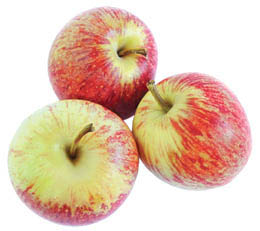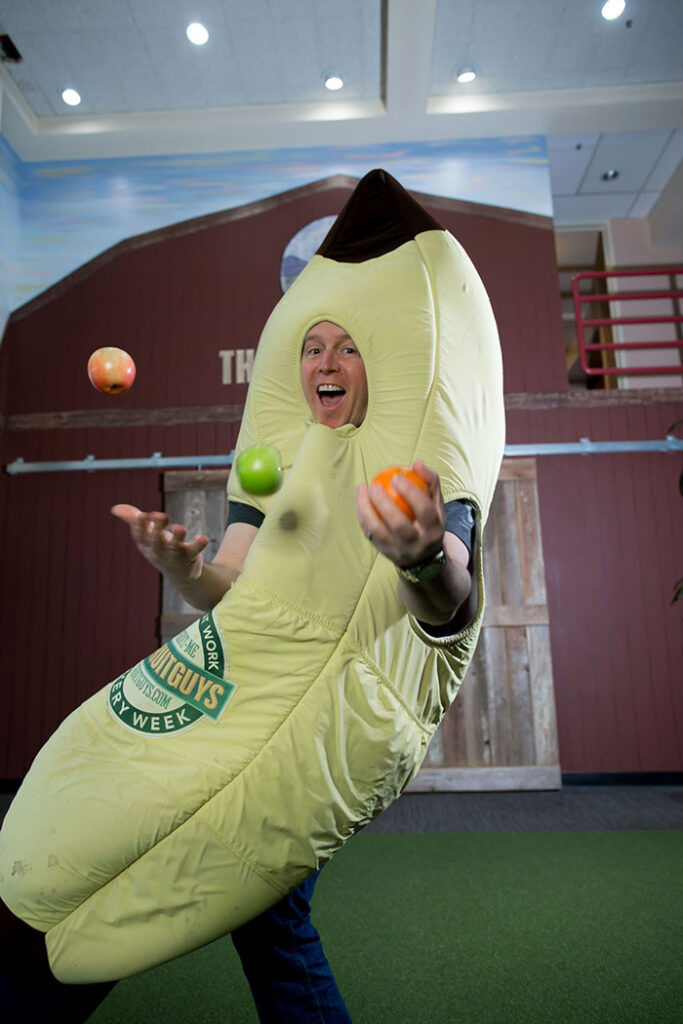Ode to a Grav Grower
- By Pia Hinckle
- Last Updated On
- Reading Time: 4 mins.

Lee Walker has been farming with his family in their Graton, CA, apple orchard his whole life, except for a tour in the army and a few years playing pro baseball. Lee has kept growing Gravenstein apples through both the thick and the thin-skinned times of the apple business.
“We’ve been seeing for a long time that if we could just hang in there, the apple business would be[come] a good business,” said Lee. “And now Gravensteins are a specialty item!”
Walker Apples is the last commercial grower of the endangered Gravenstein apple. These apples had their heyday in the 1940s when they were in such abundance that they were fed as applesauce to U.S. troops during World War II. During the last six decades, the Gravenstein has fallen victim to changing tastes and produce distribution trends. As a short-season apple that does not store well and often needs to be hand-harvested because of its weak stem, acres upon acres of the trees were torn out for more high yielding crops, especially wine grapes and housing developments, in formerly rural Sonoma County.
Want farm-fresh fruit?
We've got you covered.
Lee almost gave up on the Grav himself. Featured in The Los Angeles Times, the 80-year-old farmer admitted that he too planted a couple of acres of grapes that some years brought in more revenue than his entire Gravenstein harvest.
Thanks to the efforts of Slow Food Russian River and The FruitGuys, the Gravenstein is experiencing a resurgence as a sought-after specialty apple with a much higher national profile. Lee says since the creation of the Gravenstein Apple Presidia Project in 2004, prices for his apples have nearly doubled. This year Gravs will even be sold in some Los Angeles farmers’ markets. FruitGuys CEO Chris Mittelstaedt says they are getting calls from as far away as New York to order their annual August Gravenstein box.
Want fruit for your office?
Get your office a free sample TODAY!
 “I remember the year that [Lee] lost almost his entire crop due to sun damage and how hard it was,” says Chris. “You have to really love and be committed to preserving these heirloom varieties because financially there’s really not a lot in it for the farmer. When you only have a few growers left, you really don’t realize how thin the thread is: all it would take is a couple of bad years of weather, the farmers’ personal health, or the financial realities of running a small farm, and it could be over in an instant and you’d never taste them again.”
“I remember the year that [Lee] lost almost his entire crop due to sun damage and how hard it was,” says Chris. “You have to really love and be committed to preserving these heirloom varieties because financially there’s really not a lot in it for the farmer. When you only have a few growers left, you really don’t realize how thin the thread is: all it would take is a couple of bad years of weather, the farmers’ personal health, or the financial realities of running a small farm, and it could be over in an instant and you’d never taste them again.”
The Gravenstein Apple Presidia, run by the Slow Food Russian River chapter, is one of only six in the U.S. and the only one in the fruit category. “This project was inspired by the vision of beautiful apple orchards being chainsawed into oblivion on our country roads here in Sebastopol, and being replaced with grapevines,” said Paula Shatkin, Gravenstein Apple Presidia Coordinator. “Suddenly, our county was in danger of ”looking like Napa and other wine counties, whereas we have a long and delicious history of being an apple growing area, and we have the perfect climate for them, and we have a long cultural history of celebrating them as a community.”
The presidia work with local farmers to find out what they need to keep their orchards in production, raises money for outreach materials, organizes events such as farmers’ markets and fairs, and does outreach to the media, tourism groups, and community organizations.
Chris Mittelstaedt added that while the challenges that small family farms face haven’t changed much in the last century, consolidation by large growers and marketers to control the storage, distribution, and, marketing of produce has put even more risk back on small growers. “The sad part is that when you have an apple that has fallen out of favor commercially, like the Grav, keeping it available for people and keeping people excited about it is difficult because of the way we purchase and distribute produce now.”
Want farm-fresh fruit?
We've got you covered.
Color and Taste
Lee’s Gravensteins come in two varieties: red and green. The green Gravensteins tend to have a tarter flavor and are beloved by bakers for apple pies and tarts. The reds tend to be stripped or spotted and are quite sweet. They both have a slightly tacky peel and a singular mix of tart and sweet taste when eaten with the peel. Lee says Gravensteins grow so well in western Sonoma County because of the climate: they love the sandy loam soil, the cool morning fog, and the hot afternoons. The winters are cold enough for the trees to go dormant, but not usually for frost.
Lee’s grandfather (Arthur Upp) planted the first Gravenstein apple orchard on their property in 1912. Today Lee grows 25 varieties of apples on his farm, each with different maturity and pick a date. Lee’s harvest starts with the early varieties in August and goes into November. If you follow the bumpy road down into Lee’s farm in August, you’ll end up in a quiet and peaceful bowl-shaped valley where the apple trees spill down hills and pickers balance on 3-legged wooden ladders while filling their shoulder-slung canvas satchels with fruit. They bring the apples down from the hills to a small packing shed where the fruit is sorted by hand and wiped clean with a cloth. Lee’s farm has produced apples that have consistently won the Sonoma County Fair’s best apple awards since the 1960s. His trophies and ribbons line a wall in the packing shed. In 2008, Lee was awarded the Lifetime Achievement Award for contributions to Sonoma County Agriculture by the Sonoma Harvest Fair.
Get tips for your office
Be an office hero!
Pia Hinckle is a publisher at The FruitGuys.
Recent Articles
Fresh From the Midwest: Lehman’s Orchard Grows Sweet Apples and More
Your Red Kiwi Guide: How It Compares to Its Colorful Cousins
Tasty Thanksgiving Recipes from The FruitGuys Team
The FruitGuys Ranks Among San Francisco’s Fastest-Growing Private Companies
Corporate Wellness Program Planning: Your 2026 Guide to a Healthier Workplace
Subscribe to our Newsletter
"*" indicates required fields



